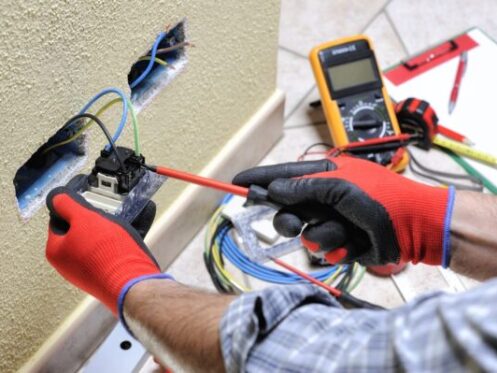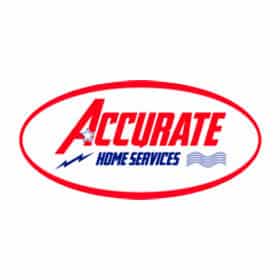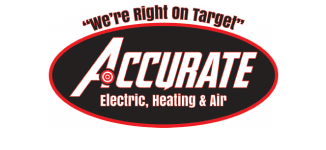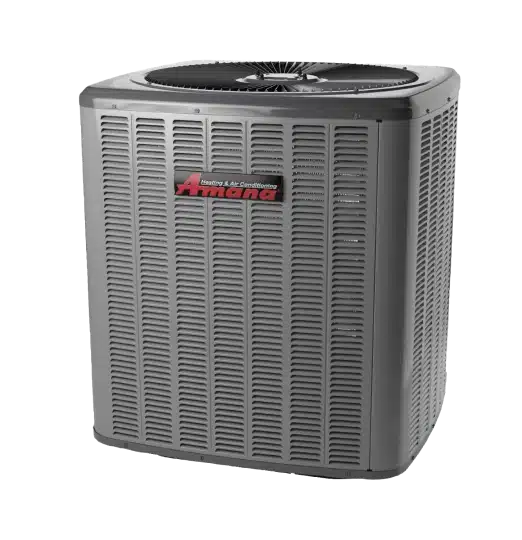Updated: June 24, 2024
Today’s world runs on outlets. Appliances, devices, and tools need electricity to operate. Even the batteries for cordless items need an outlet for charging. Interior and exterior outlets sit on the walls of your home, but they might not provide the same flow (voltage) or volume (amperage). The electrical team at Accurate Home Services describes the difference between electrical outlets installed in your Crandall home.
Common 15 Amperage, 120 Volts Outlets
The outlet most homeowners are familiar with is these older two and three-pronged designs. Two-prong receptacles have a hot and a neutral wire. It was a standard design in mid-20th-century home construction but is missing a ground wire that prevents electrocution, fires, and damage to items plugged into it. The three-prong outlet includes a ground wire for increased safety and became required in new homes in 2008.
The 15-amperage, 120-volt outlets are cheap and easy to install or replace. Receptacles usually contain two sockets and will be found throughout the home and outlying building or exterior walls. These outlets accept the standard plugs on smaller appliances, electronics, and lamps.
Older two-prong outlets are less safe and make prime candidates for replacement. Many of the outlets discussed below are substitutes for these two- and three-pronged designs.
Appliance 20/30/50 Amperage, 250 Volts Outlets
Appliances requiring these higher voltages include air compressors, dryers, electric stoves, large ovens, some freezers, shop tools, and water heaters. The plug on the device must match the outlet design.
We often see projects that add one or more 250-volt outlets to basements, garages, or workshops. If you plan to add specific equipment, talk with a technician to determine what amperage you need; 20 amps are standard, but some appliances and tools may require more amperage.
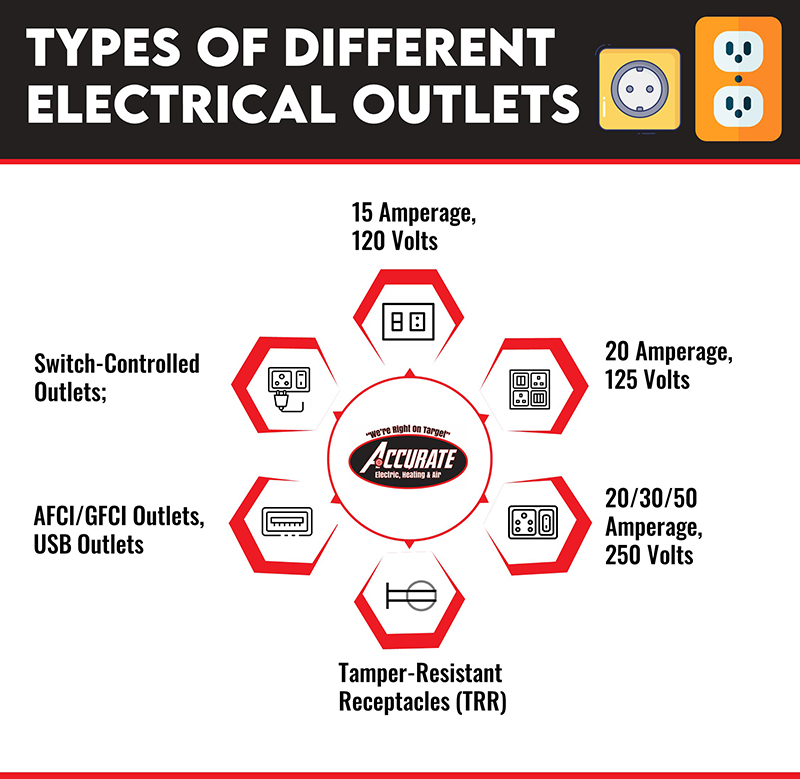
Upgraded Power in the 20 Amperage, 125 Volt Home Outlets
You might have noticed some outlets with a horizontal slot along the verticle ground slot. That lets you know this receptacle provides an increased 20 amps of power, and the design prevents you from plugging the wrong device into the socket.
You usually encounter these outlets in areas where larger appliances get used. Some of the equipment you see plugged into a 20-amperage, 125-volt outlet includes dishwashers, laundry machines, microwaves, refrigerators, space heaters, and washing machines.
These are often wired similarly to 250-volt outlets in that they become dedicated to powering one piece of equipment. The plug orientation prevents you from using these outlets for smaller appliances, electronics, and lamps.
Tamper-Resistant Receptacles (TRR)
The National Electrical Code requires these standard-looking three-prong outlets in new and renovated homes. They function just like other outlets, but they include an internal shutter that helps to prevent foreign objects from being inserted into the plug slots.
The shutter design blocks both slots and will not open when something gets pushed into one side of the outlet. A two-blade or grounded plug makes contact on both sides of the outlet, engaging the shutter and opening it.
You may feel the shutters engaging when you plug something into the outlet, but they function like a standard plug. If excessive force is needed, it is likely the plug’s prongs and not the shutters on the outlet that are the issue. These make ideal upgrades for older outlets in homes with small children.
AFCI and GFCI Outlets
Arc Fault Circuit Interrupter (AFCI) and Ground Fault Circuit Interrupter (GFCI) outlets also get listed as mandatory equipment by the National Electric Code on new or remodeled homes. These outlet designs improve safety and help reduce the chance of home fires.
AFCI outlets trip circuit breakers when it senses high or low current arcs caused by loose connections or wire damage. They get used on branch circuits in places like bedrooms, dining rooms, family rooms, and kitchens.
GFCI outlets detect changes in the current flow that indicates a ground fault, protecting you from shocks caused by electricity taking a path through you instead of the circuit. Bathrooms, garages, kitchens, and exterior outlets are some locations where building codes require GFCI outlets and breakers.
USB Electrical Outlets
USB charging is crucial in today’s world filled with Bluetooth devices, laptops, tablets, and smartphones. If you do not already have one or more of these outlets, a trained technician can install one for you.
Why should you consider a USB electrical outlet? They eliminate the need for plug-in chargers. That not only declutters your outlets but also opens one or both three-prong receptacles for other devices to plug into for power. The USB ports on these outlets may charge your device faster than plugging it into your laptop or television. Some outlets switch off once the charge is complete, saving energy.
Smart Outlets
Smart control and device technologies are other modern conveniences growing in popularity with today’s homeowners. Some newer homes include this technology in wall outlets, and you can also upgrade standard outlets.
The ability to program when one of these receptacles is operational allows you to save money. They can also reduce energy consumption by eliminating power draws while items plugged into the sockets are in standby mode. A smart plug allows you to use your phone or voice to turn devices off or on, and you can program them to operate during specific times. The technology can also control the outlet remotely when you are away from home.
Switch-Controlled Outlets
These are usually standard outlets in older homes connected to a wall switch. The outlet receives power when the wall switch is on and has no electricity when it is in the off position.
The advantage of this design is that you can turn off and on all devices powered by the outlet at once. It is also a great way to eliminate the power drain from electronics on standby mode, which can account for up to 25% of the energy used by some devices.
Get Help With Electrical Outlets and Much More
At Accurate Home Services, we can help you select and install the right outlets for your needs and assist with other electrical projects. Using professional technicians for fixture installations, updated surge protection, panel upgrades, or home EV charging systems helps meet building codes and is often required for warranty coverage. Our team can also help with your air conditioning and heating needs. Our family-owned business has excelled at building a reputation for quick and reliable customer service over the last 28 years. If you need HVAC or electrical installations, repairs, or maintenance services in the Crandall, TX, area, contact Accurate Home Services today and get your home upgraded!

